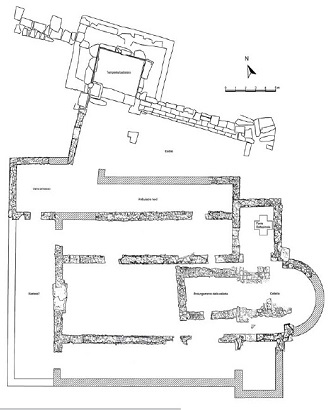

Basilica
In the flat and large section in the central-eastern part of the hill, there was a small temple, perhaps Doric. In front is located the Christian basilica. The naos of the temple was used as part of the baptistery outside and around was built a new complex employing the ancient walls as a "fence" of the baptismal font. The small temple (7.50 x 5.80 m) was made out of local sandstone and placed on the edge north of the square in a rocky rise. with an area apparently free on the front, obtained by regularizing the rocky terrain. The leveling of the square can be dated in the first half of the third century. BC.
Between the late fifth and early sixth century. A.D. a Christian basilica was built in center of the square , with three naves with a transept and small apse, equipped with narthex and exonarthex. The implementation of bunkers and other military installations have heavily damaged the front of the building. The baptistery was as early as the end of the sixth century abandoned and replaced by a small baptismal with Greek cross , built at the north transept.
The basilica was rebuilt probably in the eleventh - twelfth century. The building finally collapsed in the thirteenth century, as demonstrate the stratigraphic data in the remains. collapse preceded by subsidence roof as early as the tenth century or earlier. Nine coins have been found, six of solid gold and three silver miliarensi of the Byzantine emperors Constantine VII Porphyrogenitus and his son Romano II , dating from about the middle of that century. After the complete collapse of the basilica a small chapel was build with a graveyard used until the fifteenth and sixteenth centuries . Perhaps the first use of the cemetary area dates already back to the proto- Byzantine age, but the tombs found here are almost always very modest and no objects remain in large number.